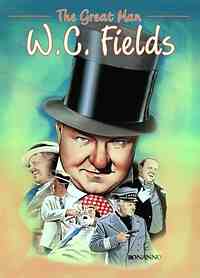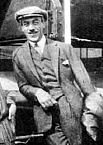HISTORY OF HUMOUR IN CINEMA
by
DONALD DEWEY
_______________
Don
Dewey has published 25 books of fiction, non-fiction and drama,
including Marcello Mastroianni: His Life and Art, James
Stewart: a Biography and The
Art of Ill Will: The Story of American Political Cartoons.
The
setting can be an elegant restaurant, an over-furbished library,
or a dank cellar. Present are one American and one or more
foreigners. The foreigner wants something of value from the
American --- an object, a piece of information, some other
concession. He is willing to be polite about getting it, but
a threat in the air suggests he has no objection to resorting
to violence for his purposes, either. The American tries to
disguise his discomfort by cracking wise about the foreigner’s
persistence --- upon which the foreigner, whether born in
Hamburg, schooled in Algiers, or married in Kuala Lumpur,
will utter the immortal line: “Zat most be ze famus
Amerikan senz off yamur.”
 The
famous American sense of humour. It is a national trait that
Americans have had ascribed to them on movie screens for decades.
The chest expands before the compliment. Along with loving
children and being kind to animals, being recognized for a
sense of humour forms the holy trinity of reassurances sought
by any culture that deems itself humane and enlightened. Who
would want to deny having a sense of humour? Godliness and
cleanliness pale next to it.
The
famous American sense of humour. It is a national trait that
Americans have had ascribed to them on movie screens for decades.
The chest expands before the compliment. Along with loving
children and being kind to animals, being recognized for a
sense of humour forms the holy trinity of reassurances sought
by any culture that deems itself humane and enlightened. Who
would want to deny having a sense of humour? Godliness and
cleanliness pale next to it.
But
wait. What American sense of humor? George Washington’s?
George Carlin’s? That of George W. Bush’s speechwriters?
What George are we talking about here? And since when has
it been so famous? Did I miss those high school history classes
that would have told me how much of a cutup George Custer
had been at the Little Big Horn? Conversely, have I been completely
imagining those bookstore shelves filled with collections
of French bon mots, Czech ironies and Irish outlandishness?
Some of the material in them goes back centuries, doesn’t
it? When did Europeans, especially, become good only for an
occasionally sardonic expression of a keenly felt smugness
(that made them calculating, not comical)? Just exactly when
did the United States win not just World War I, World War
II, the Race to the Moon War, the Grenada Dental School War,
the Cold War, the Miniature Gulf War, and the Halliburton
War, but also the Funny War? From what private stock of chauvinist
spirits have those generations of California screenwriters
been drinking?
One
clue is that word “famous.” Remember the last
time we heard it -- for describing those Page Six and “Entertainment
Tonight” party-goers who were famous because they were
famous? Could this be another example of that media rush we
have come to embrace as cultural attribute, the alternative
being that gloomy feeling of being left out, left behind and
left at the curb? As we know, the only thing worse than being
accused of lacking a sense of humour is being oblivious to
lacking it.
A second clue is the medium -- motion pictures -- that has
done so much to propagandize our humour superiority as fact.
That line about the famous sense of humour became boilerplate
more or less in the 1930s, the period when the Grants, Hepburns
and Astaires were sweeping through the suave, the brilliant
and the zany. To read some film histories, that marked the
coming of age of screen comedy -- and it didn’t happen
in Bucharest. Nor did it happen on a theatre stage where only
a few hundred people could appreciate it. The movies were
critical not only for making the humour cultural claim for
Americans, but for making it around the world three or four
shows daily to millions.  When
the projector spoke, we listened, relishing the thought that
audiences in lederhosen and saris were hearing the same announcement
in their villages. If they accepted us as the most humourous
people on earth, who were we to object?
When
the projector spoke, we listened, relishing the thought that
audiences in lederhosen and saris were hearing the same announcement
in their villages. If they accepted us as the most humourous
people on earth, who were we to object?
Who
are we to object even now? However pretentious, what harm
can such a claim do? Saying we have a famous sense of humour
is hardly as ominous as saying we have a famous sense of habeas
corpus; just because that boast served as the prelude to ugly
contradictions doesn’t mean we’re all soon going
to be banning jokes as a security measure against terrorism.
Saying we have a famous sense of humour might be vain typology,
but that doesn’t make it lethal to non-Americans taking
us at our word, does it? Aren’t we entitled to a small
illusion of homeland security?
Sure
we are -- provided we forget about history. And that’s
led to serious problems before.
 Since
motion pictures have been so instrumental in illuminating
our humour chromosomes, let’s start with their history.
By now it is practically a military secret that in its earliest
days film humour was very much a European province. The grandfather
of all movie laughter was Louis
Lumiere’s L’Arroseur arrosée,
an 1897 French short that depicts a jaunty gardener watering
his lawn, a boy sneaking up to step on the hose, the surprised
gardener examining the nozzle of the hose to see what’s
wrong, and the boy immediately stepping off the hose again
to soak his victim. Thomas Edison was so taken with L’Arroseur
arrosée that he copied it for his 1898 one-reeler “Washday
Troubles,” bothering only to substitute a tub of soapy
water for the hose.
Since
motion pictures have been so instrumental in illuminating
our humour chromosomes, let’s start with their history.
By now it is practically a military secret that in its earliest
days film humour was very much a European province. The grandfather
of all movie laughter was Louis
Lumiere’s L’Arroseur arrosée,
an 1897 French short that depicts a jaunty gardener watering
his lawn, a boy sneaking up to step on the hose, the surprised
gardener examining the nozzle of the hose to see what’s
wrong, and the boy immediately stepping off the hose again
to soak his victim. Thomas Edison was so taken with L’Arroseur
arrosée that he copied it for his 1898 one-reeler “Washday
Troubles,” bothering only to substitute a tub of soapy
water for the hose.
France’s
other great film pioneer, George
Melies, was first of all a comic satirist, specializing
in technical gags that reflected his earlier career as a professional
magician. His 1899 piece, The Conjuror, is a flashy series
of vanishing acts and physical displacements aimed at laughs.
And only the reverence accorded the 1902 fantasy A Trip to
the Moon for its influence on the film medium as a whole obscures
the parodies at the heart of Melies’s treatment of many
of its characters. Most seminal of all in the evolution of
cinema humour was yet another Frenchman, Max Linder (Gabriel-Maximilien
Leuvielle), whose dandy lay-about character polished film
slapstick, established him as the world’s leading comedian
up to World War I, and served as an inspiration for Mack Sennett
and Charlie Chaplin.
Other
European countries were not too far behind France in going
for the funny bone; indeed, the only conspicuous exception
between the turn of the 20th century and World War I was Russia,
where the Czar clamped an iron hand over any film project
that failed to celebrate the Romanovs or great patriotic figures. In Germany, Oskar Messner starred in a number of risqué
comedies that were popular not only in his own country and
around Europe, but also in the
United States. Long before he had gained a reputation as a
masterful director of sophisticated comedy, Ernst Lubitsch
had developed a following on the continent for a series of
comic shorts in which he played a German bumpkin named Meyer.
Around the same time in Sweden, Mauritz
Stiller was crafting a Scandinavian genre of
ironic comedy, but not so preciously that there wasn’t
room for scores of pratfalls and various other visual gags
in works like The Modern Suffragette (1913) and When the Mother-in-Law
Reigns (1914).
In Germany, Oskar Messner starred in a number of risqué
comedies that were popular not only in his own country and
around Europe, but also in the
United States. Long before he had gained a reputation as a
masterful director of sophisticated comedy, Ernst Lubitsch
had developed a following on the continent for a series of
comic shorts in which he played a German bumpkin named Meyer.
Around the same time in Sweden, Mauritz
Stiller was crafting a Scandinavian genre of
ironic comedy, but not so preciously that there wasn’t
room for scores of pratfalls and various other visual gags
in works like The Modern Suffragette (1913) and When the Mother-in-Law
Reigns (1914).
 In
London, Robert
Paul, the first exhibitor of British
films to a paying public, began turning out comic shorts before
the turn of the century with the confidence that they would
be his most profitable source of income. One of the most technically
elaborate and financially successful of all British films
before World War I was A Suffragette in Spite of Himself (1912),
a revival of the pranksterism from Lumiere’s L’Arroseur
arrosée in its tale of an obnoxious male chauvinist
who walks around London unaware that teenagers have stuck
a pro-feminist declaration on the back of his coat. Comedies
were also a film staple in Denmark, Italy and Hungary.
In
London, Robert
Paul, the first exhibitor of British
films to a paying public, began turning out comic shorts before
the turn of the century with the confidence that they would
be his most profitable source of income. One of the most technically
elaborate and financially successful of all British films
before World War I was A Suffragette in Spite of Himself (1912),
a revival of the pranksterism from Lumiere’s L’Arroseur
arrosée in its tale of an obnoxious male chauvinist
who walks around London unaware that teenagers have stuck
a pro-feminist declaration on the back of his coat. Comedies
were also a film staple in Denmark, Italy and Hungary.
The
genre continued to rule throughout Europe’s silent film
era. As box office receipts on both shores of the Atlantic
confirmed, foibles were foibles, and exposing them, exaggerating
them and enjoying them were pastimes without borders. But
then came sound, and the predilection by movie makers to hang
more of their humour on dialogue. What was funny grew vulnerable
to extra-national translation problems that were not always
resolved happily; i.e., verbal idiosyncrasies hilarious in
Italy might only perplex audiences in the Netherlands dependent
on approximate subtitles or syllable-conscious dubbing. Moreover,
the very prospect of foreign verbal comedy could daunt audiences
in a way imported dramas, action adventures and mysteries
did not because it called for an ongoing, expressive participation
from the spectator known as laughter. It didn’t really
matter whether the absence of that laughter was due to the
original film, inept subtitling or dubbing, or the obtuseness
of the viewer in the orchestra; the main thing was that audiences
expected to laugh that didn’t laugh were very uncomfortable
audiences, and uncomfortable audiences were unlikely to expose
themselves to a potentially disagreeable situation a second
time. The upshot was that, lacking a major star to assure
long lines outside the cashier’s booth in both Lisbon
and Warsaw, comedies became the least desirable film genre
in Europe in the first decade of sound.
If
American studios experienced fewer problems on the continent,
it was largely because of their control of European distribution
networks and block booking: To get Greta Garbo, Switzerland
also had to take some B comedy about Nebraska wheat growers
and make the best of all those jokes about Lou Gehrig. But
even in this monopolistic context it soon became evident that
some very important figures in American screen humour -- Will
Rogers, W.C. Fields, Philip Barry, S.J. Perelman and George
S. Kaufman, to name just five -- did not travel well in Europe.
(Although somewhat more popular, Groucho Marx would have to
wait years for his work to gain recognition as more than an
appendage to Harpo’s antics or even to his own makeup).
At the same time, in a market already restricted to a handful
of foreign imports every year, European comedies of the 1930s
found little of the enthusiasm in the U.S. that had welcomed
Max Linder and Oskar Messner. Whether it was Rene Clair’s
A Nous la Liberté (1931) or even a British comedy such
as J.B. Priestley’s The Good Companions (1933), satire
was still something that closed on Saturday night.
Of
course, European film comedy in the 1930s was up against more
than the problems posed by sound and block booking. In Germany
there was Adolf Hitler, in Italy there was Benito Mussolini
and in the Soviet Union there was Joseph Stalin. Spain went
through two upheavals to end up with Francisco Franco, and
the entire continent staggered under an economic depression.
If European film makers concluded there was not too much to
laugh at, they could be forgiven their grasp of reality. If
they decided that attempts by the continent’s various
dictators to encourage more comedies in order to generate
an illusory sense of national well-being defined whistling
in the dark, they could be equally pardoned. Genuine laughs
simply didn’t come easily in the Europe of the 1930s.
Nevertheless,
it was a giant leap from the perception that nationally flavoured
comedies reliant on dialogue humour from severely tested countries
were not so exportable to the view, rampant in Hollywood films
from the early 1930s, that the only good European was a humourless
European. That judgment required considerable reaching, starting
with the need to ignore the European comedies the American
industry knew were out there along with the latest grim Fritz
Lang masterwork. Paradoxically, it required Americans to take
themselves more seriously; i.e., to be more consciously ideological.
It also required absolute denial that this was what was going
on.
The first public figure recorded as using the word ‘ideology’
disparagingly was Napoleon, when he shrugged off French philosophers
opposed to his imperial ambitions as “mere ideologues.”
Gradually, the word degenerated into a synonym for everything
from inert intellectualism and overripe theorizing to dogma
and outright lie. Outside academe, few held to the term’s
fundamental meaning as a would-be total view of human activity
and purpose enlisting the dynamics of intellectual speculation,
idealistic belief and social arrangement. Fewer still were
those who, not hypnotized by the neat schematics of their
own worldview, acknowledged the constant shifts of perspective
necessitated by evolving realities and envisioned by French
philosopher DeStutt de Tracy when he proposed ideology as
a new science of ideas at the beginning of the 19th century.
When ideology didn’t invite rejection for being its
own worst ism, in other words, it was ridiculed or dismissed
for parenting harmful offspring.
Sometimes
the children haven’t even had to seem menacing to be
spurned. One striking feature of American skepticism toward
isms is that, while most often explicitly addressed to the
aspirations embodied in European anarchism, fascism and communism,
it has also been close to the surface in attitudes toward
the ideological contents of the French Revolution and even
those of the American Revolution. A review of the U.S. mass
media’s understanding of the French Revolution over
the years, for example, would disclose little more than a
social eruption that began in the best of times and worst
of times and that ended with some people doing a far, far
better thing than they had ever done before -- if only because
the Scarlet Pimpernel couldn’t save them in time. At
home, once having dispensed with terms like freedom and independence,
we appear to have exhausted our interest in the social and
political substance of the American Revolution. Certainly,
it has been less taxing to dwell on the image of a colonial
rebellion rather than on that of a revolution proper, since
this has allowed us to regard ourselves as emotional, instinctual
and ultimately responsive only to what any aggrieved innocent
would have been responsive to in such oppressive circumstances.
Has
it been mere coincidence within this anti-intellectual tradition
that the entertainment media’s treatment of the American
Revolution has, after the singing and hoofing of 1776, mostly
started and stopped with television serials adapted from mass
paperback romances and best-selling biographies? Doubtlessly
assisted by the calculation that enemies who sport powdered
wigs and fire one-shot muskets aren’t anywhere near
as enthralling in trailers as unkempt rebels charging down
a hill and blazing away with Colt .45s, Hollywood (but also
Publishers Row and other hubs of public fantasy) has tended
to take D.W. Griffith at his word that the Civil War, not
the War of Independence, marked the birth of the nation. And
of course the true values of that conflict, as we have been
told since grammar school, were simplicity itself: no secession
and no slavery, hallowed propositions requiring no more thought
than that needed for espousing freedom and independence.
But
the scarcity of persuasive fictional portrayals of the American
Revolution has not prevented film makers from attempting to
define the American character or the values supposedly shaping
it; on the contrary, once moved to a safer (more commercial)
contemporary setting, that task has been a preoccupation of
reflective film makers since -- wouldn’t you know it?
-- the 1930s. Even today a poll asking where American social
and cultural beliefs have found their clearest and most potent
cinematic expression would yield as a popular answer Frank
Capra’s Everyman pictures in the 1930s
and 1940s, when Mr. Smith went to Washington and Mr. Deeds
dropped in on the town. And what exactly were the values advocated by Capra through
his James Stewart and Gary Cooper heroes even as they both
were deluged by seas of cynicism? Honesty, for one. The rewards
and satisfactions to be gained from hard work, for a second.
The democratic right to happiness, for a third. In other words,
no principle normally thought of as -ismic; indeed, nothing
that required any of that book learnin’ at all. As Mr.
Smith made clear during his filibuster, the only modern text
worth paying attention to was the Constitution; as Mr. Deeds
demonstrated, the only honest writing was to be found in the
doggerel of greeting cards -- a tip of the hat to the Bible
for having inspired the best sentiments of both.
And what exactly were the values advocated by Capra through
his James Stewart and Gary Cooper heroes even as they both
were deluged by seas of cynicism? Honesty, for one. The rewards
and satisfactions to be gained from hard work, for a second.
The democratic right to happiness, for a third. In other words,
no principle normally thought of as -ismic; indeed, nothing
that required any of that book learnin’ at all. As Mr.
Smith made clear during his filibuster, the only modern text
worth paying attention to was the Constitution; as Mr. Deeds
demonstrated, the only honest writing was to be found in the
doggerel of greeting cards -- a tip of the hat to the Bible
for having inspired the best sentiments of both.
As
the scores of Hollywood films unspooled after Smith and Deeds
argued repeatedly, these core values had absolutely nothing
in common with the ideologies that had taken root in Europe
in the 19th and 20th centuries, neither in content nor in
form. For openers, the European ideologies would have been
inconceivable without their elaboration and argumentation
in books and periodicals -- suspect intellectual arenas to
congressmen and jingle writers. To one level of sophistication
or another, anarchism, fascism, and communism (the three most
prominent isms) were programmatic philosophies that proposed
specific steps to reach specific objectives. In their realization,
action was stipulative, not instinctive; was predicated on
theoretical as much as social achievement. Even those not
sharing the European ideology in question were directly relevant
to its embrace as active or potential foes, as part of the
problem when not of the solution. From ideology’s viewpoint,
everybody was involved.
But
despite its proud impatience with the European isms, the ideology
known as the “American way of life” has also had
its own all-inclusiveness. If only species of the lunatic
fringe have actually gone around talking about ‘Americanism’
as some philosophically delineated vision, there has remained
a much vaster consensus around the conviction that personal
ambition, agility and spontaneity animate capitalism with
a human face, and that this too includes everybody, successfully
or not, like it or not. At no time was this belief more visibly
urgent than in the 1930s, when the depression had wiped the
humanity off capitalism’s face and the ideologies from
abroad were doing all that infamous creeping into American
society. When President Franklin Delano Roosevelt called on
Hollywood to help the country through the depression (and,
later, through World War II), he wasn’t talking only
about the gangster films Warner Brothers was churning out
with the Cagneys, Robinsons and Bogarts. There was just so
much restorative entertainment to be had reminding ourselves
that crime didn’t pay. What was needed was something
accenting the positive -- the kind of buoyant affirmativeness
that made the rigors of competition and hardy individualism
easier to take even as they were being justified as cultural
premises. When you have a social outlook that often resembles
making it up as you go along, the glib isn’t that far
removed from the patriotic.
It
wasn’t a glibness completely synonymous with fantasies
about the posh and the luxurious, the way ‘white telephone’
screen melodramas were meant to divert audiences from the
daily grimness of Mussolini’s Italy. Although plenty
of Hollywood comedies were set in mansions and gave steady
employment to actors adept at playing butlers, humour was
a first democratic principle endemic to every class setting.
Millionaires were funny, hobos were funny, even gangsters
fired off cracks as regularly as their .38s. Many of the most
popular or accomplished pictures from the period -- My Man
Godfrey, Sullivan’s Travels, the Thin Man series --
rounded up all the classes for their jokes. Hitler had his
Nuremberg rallies, the United States had neighbourhood movie
theaters on every corner from New England to California.
Expropriation
of some universal human quality for a claim of cultural primacy
is nothing new; the function of propaganda has always been
to dehumanize the enemy in one way or another. In the particular
case of the 1930s and 1940s, there might have been no refuting
the enemy’s efficiency (Nazi), zealotry (communist),
or recklessness (anarchist), but without that leavening ability
to laugh at himself as much as at others, he (or she, if she
was Ninotchka) was a loser. As long as there was humour in
one’s makeup, even despair (a constant in the Capra
films) turned out to be a temporary aberration. Humour crystallized
the whole man, the completely committed man, the victorious
man. It was from the hierarchy of divine blessings. One ideology
was indeed more inclusive than the rest -- and would have
the armies, foreign aid and gross national product to prove
it for decades to come. He who laughed most laughed last;
he who laughed least didn’t last.
Which
should make us wonder about the ideological significance in
more recent times of resorting to laugh tracks.
Also
by Donald Dewey:
Cartoon
Power